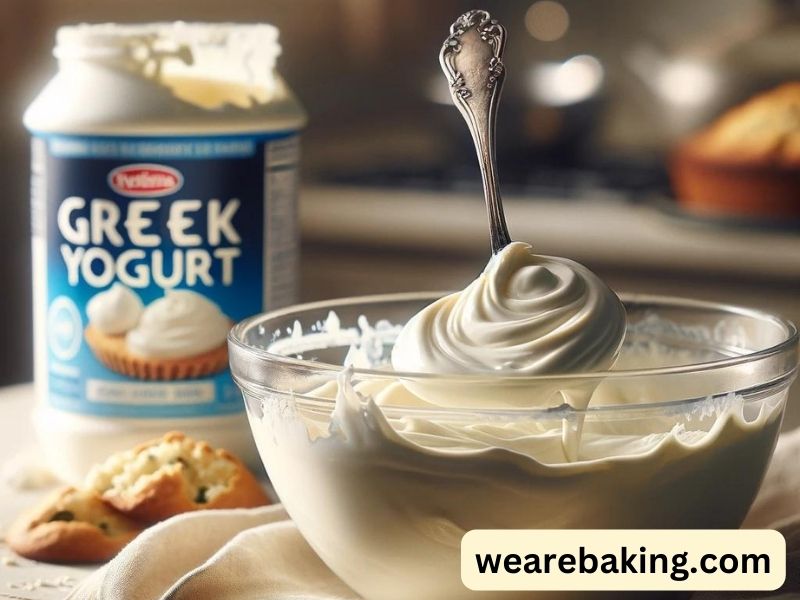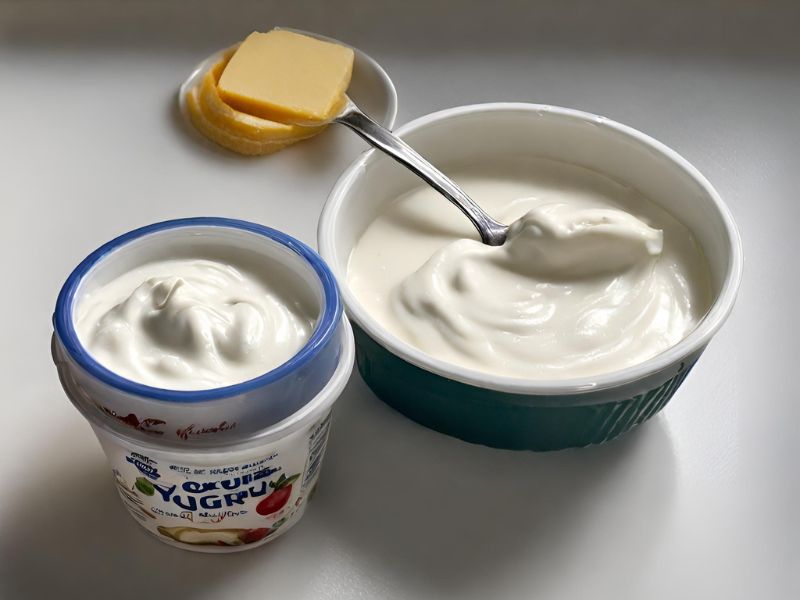You can often substitute plain, unsweetened Greek yogurt for sour cream in baking! This simple swap adds a tasty tang and moisture to all kinds of baked goods, from cakes to cookies and more. While Greek yogurt is the ideal type for the swap, you can also use regular unsweetened yogurt as well with just a bit of tweaking.
When You Need a Substitute

We’ve all been there – you start gathering ingredients to bake those yummy cookies or that cake you’ve been craving, only to realize you’re completely out of sour cream. Sure, running to the store is an option. But what if you’re short on time or just don’t feel like running across town?
This is when knowing about sour cream substitutes can be a total lifesaver. You’re likely to already have ingredients on hand that can step in and save the day. You have choices from cream cheese to lemon juice to good ol’ milk combined with vinegar. But one of the very best stand-ins for sour cream is Greek yogurt. Thick, creamy, and with a tang not far off from sour cream.
You can use regular yogurt instead of Greek, but it needs some adjusting. Regular yogurt tends to be thinner, so straining it first creates a thicker base better for baking. The flavor also tends to be more tart, so adding a touch of sweetener helps balance the acidity. With the right adjustments, regular yogurt works, but Greek yogurt’s thick, mild tang makes it an easier 1:1 substitution.
Its tangy flavor complements ingredients like lemon, berries, or chocolate. For even more flavor variation, experiment with different types of yogurt like traditional Greek, coconut-based, or skyr. The possibilities are endless!
Why Greek Yogurt Works

So why does Greek yogurt make for such a great sour cream substitute when baking? A few reasons come to mind. First, it has a thick, rich consistency similar to sour cream. This means you don’t have to worry about throwing off the moisture balance in whatever delicious treat you’re making. Regular yogurt tends to be too thin, but Greek yogurt’s creaminess mimics sour cream perfectly.
Greek yogurt has a rather neutral or mild tanginess compared to regular yogurt. This makes it easy to blend into all kinds of recipes without overpowering other ingredients. At the same time, it provides enough tang to substitute for sour cream’s flavor.
Greek yogurt packs extra protein – about 2-3 times more than sour cream! So not only will your baked goods turn out tasty, but you’ll also get a nice protein boost. For even more variation, alternative yogurts, like coconut or almond-based, can work but may influence moisture and flavor more.
So when you are staring at an empty sour cream container, but you have a tub of Greek yogurt, go ahead and grab that yogurt and bake happy. Greek yogurt has the consistency, mild flavor, and protein content to pull off the swap perfectly.
How to Substitute Yogurt
When substituting yogurt for sour cream in baking, Greek and regular work differently. Both can take sour cream’s place well but need changes in how you use them. These changes depend on which yogurt you pick. Follow these tips when swapping either type of yogurt.
🍯 Yogurt Substitute Ratios in Baking 🍰 |
||
|---|---|---|
| Type of Yogurt | Substitute Ratio | Additional Adjustments |
| Greek Yogurt | 1:1 for Sour Cream | None needed |
| Regular Yogurt | 3/4 cup for 1 cup Sour Cream | Strain to thicken, add a pinch of sugar if needed |
| Brought to You by wearebaking.com 🥄 | ||
Greek Yogurt
A 1:1 ratio is typically a safe bet to follow when substituting Greek yogurt instead of sour cream. For every 1 cup of sour cream a recipe calls for, use 1 cup of Greek yogurt instead. You can tweak this ratio slightly depending on the texture you are looking for.
Just be sure to fully mix the yogurt into the other ingredients. This will prevent pockets of tanginess or uneven texture from bite to bite.
Regular Yogurt
When using regular yogurt in place of sour cream, there are a few extra considerations. First, drain the excess whey from the yogurt to reach a thicker consistency that is better for baking.
Place a fine-mesh strainer lined with cheesecloth over a bowl. Spoon the yogurt into the strainer and let it drain in the fridge for a few hours until it is thicker. Throw out the liquid whey.
Due to the higher moisture content, you may need to use a bit less. Start by using 3/4 cup of yogurt for every 1 cup of sour cream. Add a splash of milk or a pinch of sugar to balance regular yogurt’s stronger flavor.
Using Yogurt Creatively
While swapping yogurt for sour cream works wonders, why stop there? Yogurt’s texture and tangy yet mild flavor make it a flexible ingredient for all kinds of bakes—not just as a substitute!
For starters, yogurt’s moisture makes it a great addition to cakes and quick breads like banana bread, pumpkin bread, and zucchini bread. A half cup stirred into the batter makes these treats extra soft, fluffy, and irresistible. The tang also brightens up chocolate baked goods and balances out richer ingredients.
You can also use yogurt in baking when you typically use buttermilk or milk. Muffins, biscuits, pancakes, and waffles gain delicious moisture and rise beautifully with some yogurt folded in. For an extra punch of flavor and protein, try substituting half the oil or butter in brownies, bars, and cookies with yogurt instead.
In savory cooking, yogurt shines in tenderizing marinades for chicken, pork, and veggies heading to the oven or grill.
And let’s not forget about no-bake treats! Yogurt’s thick texture makes a fantastic base for healthier frostings and puddings, ice pops, chia puddings, overnight oats, and smoothies.
From breads to cakes, don’t be afraid to experiment with yogurt. Its flexible flavor and moisture begs to be baked into all kinds of goodies.
Handling Yogurt’s Heat Sensitivity
When exposed to excessively hot temperatures, yogurt can “break” or curdle, which changes its smooth texture into something more grainy or watery.
Why does this happen? It has to do with the delicate proteins and cultures that give yogurt its signature thickness and tang. Too much heat changes the structure, throwing things out of balance.
Does this mean yogurt can’t be baked at all? No, the trick is keeping temperatures gentle enough not to pass yogurt’s tolerance threshold. This does mean yogurt works better in recipes involving less or no oven time. We’re talking no-bake (or quick-bake) treats like cheesecake, chia pudding, frozen yogurt bites, and quick breads.
For baked goods, stick to recipes with shorter bake times, around 350°F or less. Items like muffins, flatbreads, and shallow-depth dessert bars handle yogurt’s sensitivity much better than pound cake or deep-dish pie. For the best texture, allow doughs that are frozen to thaw first.
Baking with yogurt successfully just requires a bit of technique. Remember that yogurt can curdle after heating it too high or too long. Choose no-bake recipes or treats with shorter baking times. This lets you get the most out of yogurt’s thick texture and tasty tang in sweet and savory creations.
🧁 Baking Adjustments with Yogurt 🎂 |
|||
|---|---|---|---|
| Adjustment Type | Detail | Recommended For | Emoji Guide |
| Baking Temperature | Reduce by 25°F (15°C) | All baked goods | 🌡️ |
| Baking Time | May need slight reduction | Cakes, muffins | ⏲️ |
| Consistency | Strain regular yogurt for thickness | When using regular yogurt | 🥄 |
| Brought to You by wearebaking.com 🍰 | |||
Frequently Asked Questions
When using yogurt as a handy sour cream substitute, you may have some lingering questions about how to tackle flavor, texture, and more. To cover all the bases, here are answers to some frequently asked questions about baking with yogurt.
Can I use flavored yogurt?
Yes, you can use flavored yogurt but the outcome will depend on the particular flavor and how it pairs with the other ingredients in your baked good. Fruit flavors like strawberry or blueberry would likely complement desserts or muffins. Meanwhile, savory flavors like garlic or herb may suit breads or scones better. Be prepared for the flavor to come through vibrantly. Opt for plain yogurt if you want a more neutral flavor profile.
What if the yogurt I have is thin?
No problem – simply strain out the excess whey to thicken it up. Line a fine mesh strainer with cheesecloth and place over a bowl. Spoon in yogurt and let it drain in the fridge for a few hours, until it reaches a thicker, Greek yogurt-like consistency. The longer it strains, the thicker it will become. Discard the drained whey.
Will yogurt noticeably change the taste?
It will impart a subtle tanginess but often enhances rather than clashes with other flavors. Spices like cinnamon or vanilla help balance out more acidity if needed. And lemon juice or other zesty ingredients complement yogurt’s sour notes beautifully. So, while the flavor will shift slightly, it likely won’t overhaul any baked good’s overall taste if using an unflavored, plain yogurt.
What are some other healthy sour cream subs?
Popular alternatives include tangy, moist ingredients like buttermilk, mashed avocado, soft tofu, or ricotta cheese. Each brings its own flavor and texture attributes but serves as creative subs when yogurt or sour cream just won’t do. Explore your options for even more ways to bake healthy treats!
Key Learning Points:
- You can often substitute plain Greek yogurt for sour cream in baking using a 1:1 ratio. With regular yogurt, you’ll likely need less and to drain the excess whey first.
- Adjust yogurt amount based on recipe, moisture needs, and desired thickness using trial and error.
- Yogurt curdles at high temps – better for cooler bakes, frostings, and no-bakes.
- Yogurt adds tang that complements lemon, berries, chocolate and more.
- Different yogurt types bring unique flavors and textures to experiment with!
Have you tried using yogurt instead of sour cream? Please leave me a comment below.
And As Always
Keep On baking!
Taianne
Share the Love

I’m Taianne, the owner and operator behind We Are Baking. Baking my first cake at age 11 hooked me on creating sweet treats. Though my interest faded during childhood, it was rekindled when I married my apple pie-loving husband. I love trying new recipes, tweaking classics, and helping others learn the science and art of baking. I started We Are Baking to share tips, tricks, and favorite recipes I’ve discovered over the years. When not in the kitchen, I enjoy spending time with family and friends. My goal is to inspire others to embrace their creativity through baking. Feel free to contact me with any questions!
Taianne@wearebaking.com

